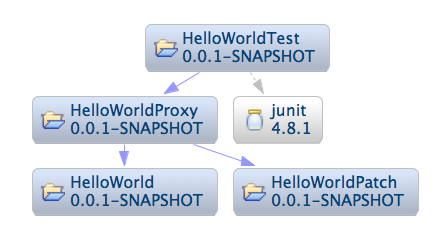Patching with Class Shadowing and Maven
Before we start, you may speculate about the usefulness of class shadowing. Class shadowing can be used as a trick to patch or replace behaviours of classes at runtime, taking advantage of the first-come first-served algorithm of Java’s class loader. If there are more than one class with the same fully qualified name in the Java class loader, the first one that shows up always take precedence over the rest.
This is extremely useful in some cases. For example, in order to make some out-of-the-box (OOTB) methods extensible without directly changing the source, or to provide backward-compatibility support, class shadowing is a good technique to separate the OOTB code and the customized code. By creating a patch jar against the OOTB jar and putting it before the OOTB jar on classpath, classes with the same qualified name are merged at runtime.
Class shadowing is only one way of patching a class. It’s based on class loader’s runtime class resolution. Another way is to use class overlay. For example, the Maven war overlays plugin expands the war file and copy them on top of the host classes.
If you are already familiar with OSGi based technology, patch fragment is actually taking advantage of the class shadowing mechanism. This post is not targeting at building OSGi application but at standard Maven project.
To instruct Java’s class loader to load jars in a specific order, we can make use of the “-cp” option. For example,
java -cp patch.jar ootb.jar -jar main.jar
It tells the class loader that patch.jar is loaded before ootb.jar, hence any classes in patch.jar is overriding the ones in ootb.jar. Besides, we can also make use of the Class-Path attribute of the jar manifest to specify the classpath. We will adopt this method in the follow-up example.
Here is an example we are going to build. HelloWorldProxy is a proxy artifact that exports its classpath in such an order that classes in HelloWorldPatch are replacing classes in HelloWorld. HelloWorldTest depends on HelloWorldProxy and doesn’t know which implementation (HelloWorld or HelloWorldPatch) HelloWorldProxy is exporting. The dependency graph is as followed:

In the pom.xml of HelloWorldProxy, it has two dependencies and we put HelloWorldPatch before HelloWorld, since we would like to see classes in HelloWorldPatch replacing the ones in HelloWorld. As of Maven 2.0.9, the ordering of dependencies on the classpath is preserved. The code snippet is as followed:
<dependencies>
<dependency>
<groupId>HelloWorld</groupId>
<artifactId>HelloWorldPatch</artifactId>
<version>0.0.1-SNAPSHOT</version>
<type>jar</type>
<scope>compile</scope>
</dependency>
<dependency>
<groupId>HelloWorld</groupId>
<artifactId>HelloWorld</artifactId>
<version>0.0.1-SNAPSHOT</version>
<type>jar</type>
<scope>compile</scope>
</dependency>
</dependencies>
We also need to make sure HelloWorldProxy exports the two jars in the Class-Path attribute of the MANIFEST.MF file with the correct ordering. The key is to set the addClasspath flag to true in the maven-jar-plugin:
<plugin>
<groupId>org.apache.maven.plugins</groupId>
<artifactId>maven-jar-plugin</artifactId>
<version>2.3.1</version>
<configuration>
<archive>
<manifest>
<addClasspath>true</addClasspath>
</manifest>
</archive>
</configuration>
</plugin>
Run “mvn package” in HelloWorldProxy and take a look at the generated MANIFEST.MF:

Voila! That’s what we expect! HelloWorldPatch takes precedence over HelloWorld on HelloWorldProxy’s classpath!
Now HelloWorldTest can safely depends on HelloWorldProxy and expects that HelloWorldProxy will export HelloWorldPatch’s implementations at runtime:
<dependency>
<groupId>HelloWorld</groupId>
<artifactId>HelloWorldProxy</artifactId>
<version>0.0.1-SNAPSHOT</version>
<type>jar</type>
<scope>compile</scope>
</dependency>
The source of this example is available on GitHub http://github.com/owenthereal/patching_with_class_shadowing_and_maven. You can also view it directly with CodeFaces http://codefaces.org/http://github.com/owenthereal/patching_with_class_shadowing_and_maven.
